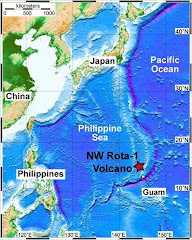March 18, 2010
We arrived at NW Rota seamount late yesterday and the question on
everyone’s mind was “would it still be erupting?” On the one hand,
the volcano has been found to be active every time it’s been visited
over the last 7 years, but on the other hand, how long could the
volcano keep this up? After we arrived, the first thing we did was
resurvey the summit of the volcano with the ship’s multibeam sonar
system, and the bathymetry showed some major morphologic changes
around the summit since last year. Next, we performed a vertical
cast with the CTD (an instrument package that measures conductivity,
temperature, depth, and optical backscatter) to look for evidence of
hydrothermal activity, and it showed that there was a strong plume
over the seamount. We’re now in the middle of making our first Jason
dive at NW Rota, and we’re seeing some big changes on the seafloor
2010 Brimstone at NW Rota-1 Volcano, Mariana Arc |
since last year. First of all, the volcano is still erupting, which
I must admit still amazes me. Ash is being vigorously thrown out of
the vent along with a billowing sulfur-laden plume. But to our
surprise, we found 2 eruptive vents instead of 1. Also, the
submarine landscape is completely altered since last year. The main
eruptive vent is 25 m deeper than last year, and there appears to
have been both major landsliding (removing the large cone we saw last
year and parts of the surrounding area) followed volcanic re-
construction (which is gradually building a new cone over the
eruptive vent). What a dynamic landscape this is!
Every year we
have seen something different, which gives us the rare opportunity to
learn about how active submarine volcanoes work. We’re all excited
to learn more about what the volcano is up to this year. Stay tuned…
- Bill Chadwick, Chief Scientist, Oregon State University
































